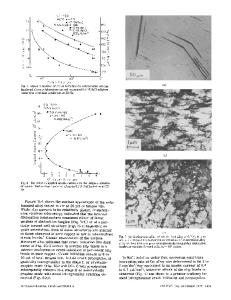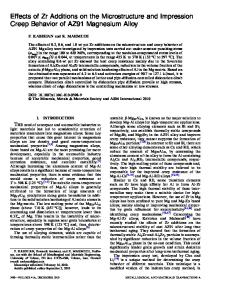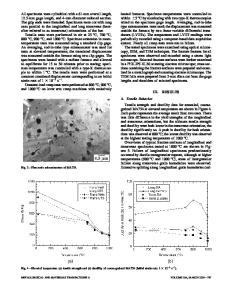The Effect of Thermomechanical Processing on the Tensile, Fatigue, and Creep Behavior of Magnesium Alloy AM60
- PDF / 1,878,956 Bytes
- 14 Pages / 593.972 x 792 pts Page_size
- 48 Downloads / 330 Views
NTRODUCTION
MAGNESIUM (Mg) alloys are lightweight structural materials that can exhibit high specific strengths. As they are approximately 75 pct lighter than steel and approximately 35 pct lighter than Al alloys, Mg alloys are considered to have promising applications in many fields where weight reduction is important, including armor, portable electronic devices, biomedical devices, automobiles, and aerospace components.[1–4] THIXOMOLDING* *THIXOMOLDING and THIXOMOLDED are trademarks of Thixomat, Ann Arbor, MI 48108.
Z. CHEN, PhD Student, and C.J. BOEHLERT, Associate Professor, are with Michigan State University, East Lansing, MI 48824. Contact e-mail: [email protected] J. HUANG, Technical Director, R.F. DECKER, Chief Technical Officer, and S.E. LeBEAU, President, are with Thixomat, Incorporated, Ann Arbor, MI 48108. L.R. WALKER, Senior Technical Staff in the Microscopy Group, and T.R. WATKINS, Senior Research Staff Member, are with the Materials Science and Technology Division, Oak Ridge National Laboratory, Oak Ridge, TN 37831. O.B. CAVIN, Research Associate, is with the Materials Science and Technology Division, Oak Ridge National Laboratory, and also Assistant Research Professor with the Center for Materials Processing Department of Materials Science Engineering, University of Tennessee, Knoxville, TN 37996. Manuscript submitted February 25, 2010. Article published online December 24, 2010 1386—VOLUME 42A, MAY 2011
is a semisolid injection molding method that originated from the semisolid metal casting developed in the 1970s.[2] Compared with traditional die-casting, THIXOMOLDING has many advantages, such as decreased turbulence and lower temperature in the molding process, which can lead to lower porosity and an associated increase in elongation to failure (ef), as well as lower shrinkage and, thus, higher dimensional stability.[1–3] The THIXOMOLDED microstructure can be altered through postprocessing treatments to tailor the mechanical properties for specific applications. This study focused on the effect of thermomechanical processing on the ambient and elevated-temperature [423 K (150 °C)] tensile, fatigue, and creep properties of THIXOMOLDED magnesium-aluminum alloy (AM60). In addition, room temperature (RT) fracture toughness experiments were conducted. All the experiments were conducted in a direction parallel with the molding and rolling plane.
II.
EXPERIMENTAL
The measured bulk chemical composition of the as-molded AM60 material is shown in Table I. The AM60 alloy was THIXOMOLDED into plates that were 3.2-mm thick,[5] and this was considered the as-molded condition. Some of the plates were then thermomechanically processed (TTMP) in order to induce dynamic recrystallization, and this represented METALLURGICAL AND MATERIALS TRANSACTIONS A
Table I.
Chemical Composition in Weight Percent of the Studied AM60 Alloy
Al
Mn
Zn
Fe
Si
Ni
Be
Mg
6.29
0.28
0.05
0.001
0.02
0.0009
0.0007
93.34
Fig. 2—Illustration of the single edge notched tension sample.
Fig. 1—Schematic illustrating the orient
Data Loading...











